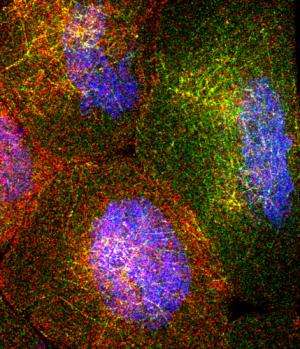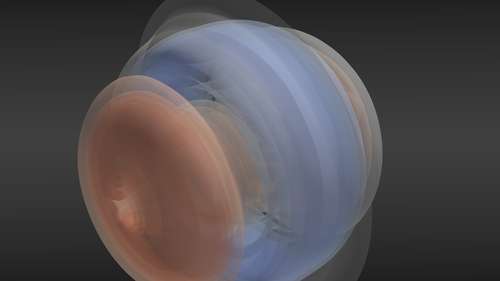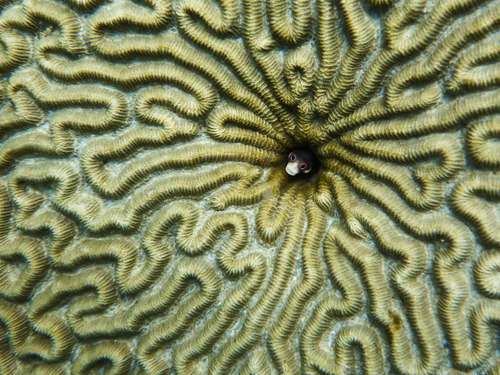Art of Science exhibit celebrates the 'unpredictability of beauty'

The Princeton University Art of Science 2013 exhibit can now be viewed in a new online gallery. The exhibit consists of 43 images of artistic merit created during the course of scientific research: http://www.princeton.edu/artofscience/gallery2013/. The gallery features the top three awards in a juried competition as well as the top three "People's Choice" images.
The physical Art of Science 2013 gallery opened May 10 with a reception attended by about 200 people in the Friend Center on the Princeton University campus. The works were chosen from 170 images submitted from 24 different departments across campus.
"Like art, science and engineering are deeply creative activities," said Pablo Debenedetti, the recently appointed Dean for Research at Princeton who served as master of ceremonies at the opening reception. "Also like art, science and engineering at their very best are highly unpredictable in their outcomes. The Art of Science exhibit celebrates the beauty of unpredictability and the unpredictability of beauty."
Adam Finkelstein, professor of computer science and one of the exhibit organizers, said that Art of Science spurs debate among artists about the nature of art while opening scientists to new ways of "seeing" their own research. "At the same time," Finkelstein said, "this striking imagery serves as a democratic window through which non-experts can appreciate the thrill of scientific discovery."

The top three entrants as chosen by a distinguished jury received cash prizes in amounts calculated by the golden ratio (whose proportions have since antiquity been considered to be aesthetically pleasing): first prize, $250; second prize, $154.51; and third prize, $95.49.
The first prize image was "East-West, West-East" by Martin Jucker in the Program in Atmospheric and Oceanic Sciences. Second Prize went to "Crushed birch," by Michael Kosk, Class of 2016, in the Woodrow Wilson School. Third Prize went to "Web of Art and Science" by Paul Csogi of the Lewis Center for the Arts and Chris Cane of the Princeton Plasma Physics Laboratory.

The juried prize winners were selected by a distinguished panel of judges: David Dobkin, Dean of the Faculty; the photographer Emmet Gowin; the poet Paul Muldoon; Shirley M. Tilghman, molecular biologist and President of Princeton University; and Katherine Bussard, Peter C. Bunnell curator of photography at the Princeton Art Museum.
Bussard said she was delighted to see the range of subject matter in the 2013 exhibit. "This year's theme of 'connections' generated such an array of images," she said. "The exhibit includes structural diagrams that resemble flowers, a close-up of cellulose that looks like an aerial photograph, and lots of pictures of worms!"
Bussard said she was particularly enchanted by a photograph of C. elegans worms under a microscope that undergraduate Meredith Wright '13 snapped with her cellphone camera. "She cleverly titled her work 'C. instagram' to drive home the way such a image shared through social media can instantly connect new audiences with science," Bussard said.
The People's Choice award winners were selected by paper ballots filled out by those attending the Art of Science 2013 opening reception. Out of 139 ballots cast, first prize for People's Choice went to "Messenger Meshwork," by Shawn C. Little, Kristina S. Sinsimer, Elizabeth R. Gavis, and Eric F. Wieschaus in the Department of Molecular Biology. Second People's Choice prize went to "Bridging the Gap," by Jason Wexler and Howard A. Stone of the Department of Mechanical and Aerospace Engineering. Third prize went to "Medusa," by Jamie Barr and Cliff Brangwynne of the Departments of Chemical and Biological Engineering and Molecular Biology.
Victoria Sanchez, a graduate student in chemical and biological engineering and one of the 2013 organizers, noted that the winners selected by the jury and those selected by visitors to the opening reception were completely different. "It is a very nice example of how subjective art is," she said. "The way you view an image can be strongly influenced by your own scientific background since each image has scientific merit as well as an aesthetic one."
The physical exhibit is located in the Friend Center on the Princeton University campus in Princeton, N.J.. The exhibit is free and open to the public, Monday through Friday, from 9 a.m. to 6 p.m.
Provided by Princeton University



















